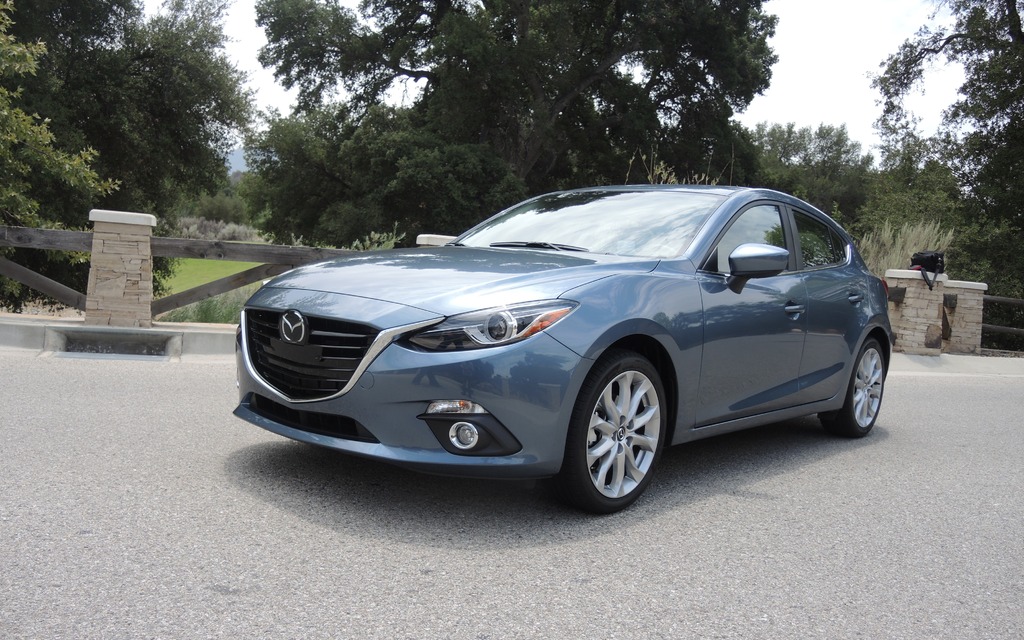2014 Mazda3: Keeping Promises

| Strong points |
|
|---|---|
| Weak points |
|
The people in charge of developing the Mazda3 and MX5 have the most stressful job at Mazda. The Mazda3 is the brand’s best selling model while the MX5 is the best-selling sport roadster in automobile history. Eventually, the MX5 will be transformed in a joint project with Alfa Romeo, so for the time being, it’s just the Mazda3 that is getting a makeover. The new Mazda3 Sport – the hatchback – was unveiled on June 26 in New York. On July 10, when the sedan was being introduced, we had the chance to test drive the hatchback. It will roll off the assembly line first, followed a little later by the sedan.
Evolution and revolution
In the same manner as the German manufacturers that offer progressive silhouettes for their cars, the Mazda3 stylists have designed an entirely new car that remains easy to identify. The biggest change is the front grille that is now similar to that of the Mazda6. Gone is the clown smile grille of the previous version. The prominent fenders extend onto the side panels and constitute its key elements. Note that the drag coefficient is .275 for the hatchback and .255 for the sedan, which is very good. A shutter located in front of the radiator grille closes in certain situations to maximize aerodynamics.
By the way, the car isn’t quite as long overall as the previous generation, and that goes for both the sedan and the hatchback. It’s also 15 mm shorter and 40 mm wider than before. As for the wheelbase, it’s 60 mm longer. The body is 90 kg lighter, depending on the version, and both are 30% more rigid.
But the major changes are in the passenger compartment, which now has a brand-new dashboard. Most of the covering materials are relatively soft, with the exception of certain sections, such as the part under the display screen. In fact, this predominant display screen is the focal point of the instrumentation. The command centre is located on the central console and is surrounded by keypads. This system helps you control everything without getting distracted and is reasonably intuitive.
On the trims equipped with head-up display, there’s a small projection screen situated just above the instrument pod. It’s clever and looks like it belongs in a space ship, but this transparent plastic screen is likely to show dust and finger prints. Mazda’s engineers say that this system was chosen because it was more compact and could be installed in several of the brand’s models. On cars equipped with head-up display, the main gauge is a rev counter, in the bottom right part of which you’ll find a small rectangle that indicates the car’s speed. The main gauge on versions without HUD is an odometer and the rev counter is located on the left. Finally, the front seats are both comfortable and supportive, while the back seats are roomier than they were in the past.
The active and passive safety systems are quite sophisticated for the category and are known as “i-ACTIVESENSE.” Among other features, there’s the Forward Obstruction Warning system that immobilizes the vehicle.
100% SKYACTIV
The previous generation of the Mazda3 included a trim with a 2.0-litre engine that used partial SKYACTIV technology, but due to a lack of space under the hood, it didn’t enjoy the full benefits of this technology. This time, however, both the 2.0-litre and 2.5-litre engines are equipped with a 4-2-1 exhaust manifold that optimizes output and ensures even more modest fuel consumption.
The 2.0-litre engine produces 150 horsepower and 150 lbs-ft of torque while the 2.5-litre generates 184 horsepower and 185 lbs-ft of torque. The 2.0-litre can be ordered with either the six-speed manual or six-speed automatic transmission, while the 2.5-litre engine comes with the six-speed automatic gearbox only.
The platform is brand new and incorporates all the SKYACTIV technology, which guarantees increased rigidity and lighter weight. The time, the suspension geometry is exclusive to Mazda, and not shared with Ford and Volvo vehicles as it was on the previous version.
Certain trims can be equipped with the ingenious i-Loop system that recovers energy produced when braking, which in turns allows the alternator to function less frequently and thus save fuel. According to Mazda, that helps reduce fuel consumption by 5% in real conditions.
The road test
No matter how pretty or technologically evolved a car may be, none of that matters if its handling is disappointing or it isn’t fun to drive. For this test drive, only the Sport (hatchback) versions were available. The first part of the test involved the GT – the best equipped version – with its 2.5-litre 184-hp engine and its six-speed automatic gearbox. Right from the get-go, the soundproofing was excellent while the engine and transmission worked in perfect harmony. What’s more, the steering was precise and well-assisted.
On a mountain road peppered with constant corners, this car was impressive. It handles corners like it’s on rails, the steering is flawlessly precise and the roll is barely noticeable. The suspension is neither too firm nor too soft. Moreover, the 2.5-litre 184-hp engine is extremely smooth and – lest we forget – the average fuel consumption is 6.8 litres per 100 km city and 4.9 litres per 100 km highway.
We returned to the hotel driving a 2.0-litre version with automatic transmission. All of the previous comments apply here too, although the engine performance was less vigorous (but still quite adequate). This engine can be paired with a very precise manual gearbox, a little like that of the MX-5 roadster.
Overall, this new Mazda3 has everything it takes to move to the forefront of the compact category.











